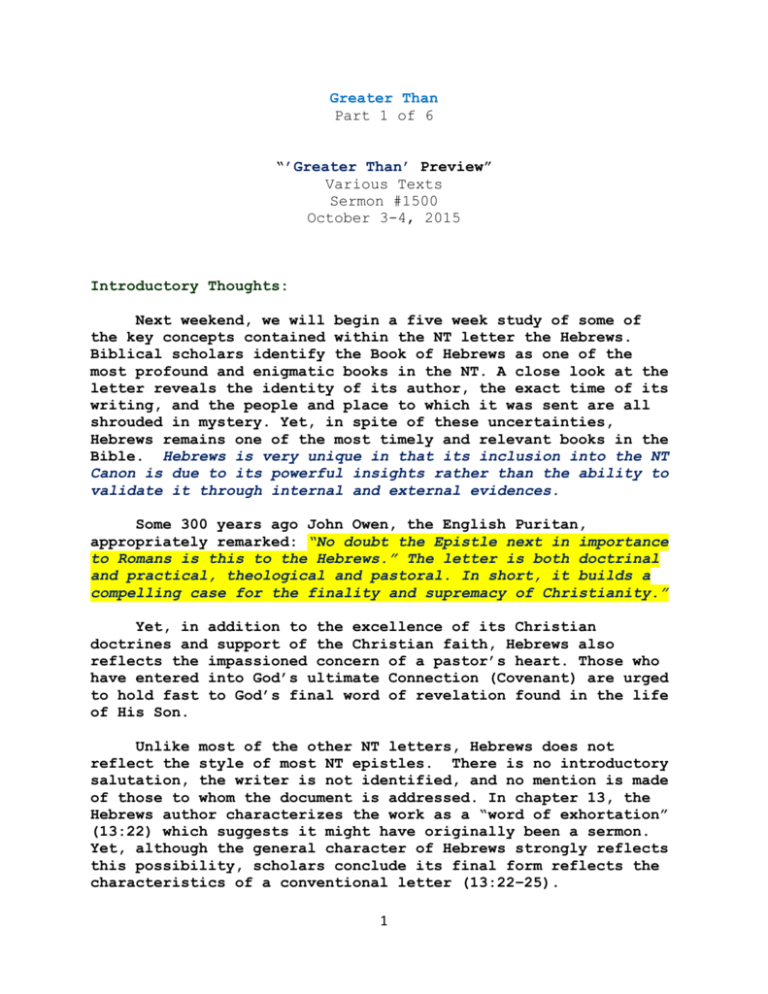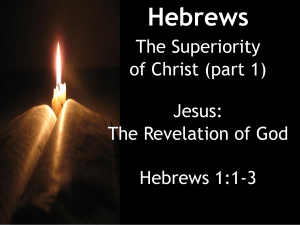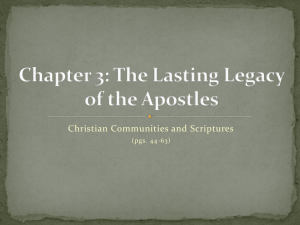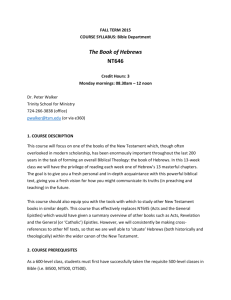Notes - Christ`s Church of Flagstaff
advertisement

Greater Than Part 1 of 6 “’Greater Than’ Preview” Various Texts Sermon #1500 October 3-4, 2015 Introductory Thoughts: Next weekend, we will begin a five week study of some of the key concepts contained within the NT letter the Hebrews. Biblical scholars identify the Book of Hebrews as one of the most profound and enigmatic books in the NT. A close look at the letter reveals the identity of its author, the exact time of its writing, and the people and place to which it was sent are all shrouded in mystery. Yet, in spite of these uncertainties, Hebrews remains one of the most timely and relevant books in the Bible. Hebrews is very unique in that its inclusion into the NT Canon is due to its powerful insights rather than the ability to validate it through internal and external evidences. Some 300 years ago John Owen, the English Puritan, appropriately remarked: “No doubt the Epistle next in importance to Romans is this to the Hebrews.” The letter is both doctrinal and practical, theological and pastoral. In short, it builds a compelling case for the finality and supremacy of Christianity.” Yet, in addition to the excellence of its Christian doctrines and support of the Christian faith, Hebrews also reflects the impassioned concern of a pastor’s heart. Those who have entered into God’s ultimate Connection (Covenant) are urged to hold fast to God’s final word of revelation found in the life of His Son. Unlike most of the other NT letters, Hebrews does not reflect the style of most NT epistles. There is no introductory salutation, the writer is not identified, and no mention is made of those to whom the document is addressed. In chapter 13, the Hebrews author characterizes the work as a “word of exhortation” (13:22) which suggests it might have originally been a sermon. Yet, although the general character of Hebrews strongly reflects this possibility, scholars conclude its final form reflects the characteristics of a conventional letter (13:22–25). 1 Following my exploration of these possibilities, I find myself taking the position Hebrews may have been a sermon presented to a local congregation and then turned into letter form when it became apparent the greater Jewish Christian community needed to hear its powerful words of truth and encouragement, as well! Date: In establishing a possible date for the writing of this letter, we have to look at bits and pieces found within the text itself. Verse 3, in Chapter 2 reveals the author of Hebrews, and probably his readers as well, had been discipled by those who were personally acquainted with Jesus (2:3). The letter suggests the Apostle Paul had already been executed and Timothy, Paul’s younger associate, was still living (13:23). Another notable item is there is no mention of the destruction of the temple in Jerusalem. One of the key principles in the Hebrews letter is the old covenant had passed away and the legal priesthood had been superseded – in addressing these issues, the author would scarcely have omitted mention of the temple’s destruction if the letter had been written later than a.d. 70. In Hebrews 9 (6–10) and 10 (1–4, 11– 14) plainly suggest sacrifices were still being offered and so we can assume this letter was written prior to a.d. 70. In addition, some scholars point to Hebrews 3:7–19 (quoting Ps 95:8–11) and suggest the argument of Israel’s 40 years wandering in the wilderness would be more forceful if the 40th year from the Lord’s death was approaching. If this is true, it would date the authorship of Hebrews about a.d. 66. In conclusion, the various strands of evidence suggest Hebrews was written sometime between a.d. 60 and 70. Origin and Destination Some copies of the manuscripts of this letter bear the inscriptions, “written from Rome,” or “written from Italy.” Such notations are educated deductions drawn from the statement: “Those who come from Italy send you greetings” (13:24). While this can be seen as denoting the writer is extending greetings to a church in Italy on behalf of Italian Christians in his church, no one can locate the letter’s point of origin with any certainty. Most NT scholars believe letter was written to a group of Jewish converts to Christianity, but no one can precisely 2 identify the precise community to which this letter was originally sent. Opinions vary from Judea to Spain to Palestine – but no one is certain. What is certain is the merits of this letter’s contents have stood the test of thousands of years of scrutiny and still provide powerful guidance to Christians living throughout the world today!1 1 Elwell, W. A., & Beitzel, B. J. (1988). In Baker encyclopedia of the Bible (pp. 943–944). Grand Rapids, MI: Baker Book House. 3 Author … Within the letter of Hebrews, we find no internal evidence directly stating who created its contents. Early 2nd century theologians linked this document with the apostle Paul. Clement of Alexandria (d. 220) theorized that Paul wrote the letter in Hebrew for Jewish Christians and the physician Luke translated it into Greek. However, this scenario has not been widely received by modern scholars. Clement’s pupil Origen (d. 254) stated more generally that the thoughts of the letter are Pauline, but the style is unlike that of the known writings of the apostle. Yet a number of factors argue against Paul being the author of Hebrews. The anonymity of the letter’s authorship is contrary to the consistent pattern of Paul’s introductory salutations. Moreover, Hebrew 2:3 indicates the writer was discipled by an eyewitness of Jesus. Yet, Paul insisted his knowledge of Christ was gained from an encounter with the risen Christ (cf. Gal 1:12). One of the great 20th century theologians, F.F. Bruce states, “We may say with certainty that the thought of the epistle is not Paul’s, the language is not Paul’s, and the technique of OT quotations is not Paul’s.” Another early Christian tradition suggested Barnabas may have written Hebrews. According to Tertullian (d. 220), many early authorities believed Barnabas was responsible for the letter. With Acts 4:36 identifying him as a “son of exhortation” (cf. Heb 13:22) and being a Levite, the letter’s encouraging tone and familiarity with the Jewish sacrificial rituals led them to this conclusion. Luther was the first to suggest that Hebrews may have been penned by Apollos. He wrote, “Apollos was an excellent man of learning, who had been a disciple of the apostles, learned much from them, and who was very well versed in Scripture.” As a native of Alexandria (Acts 18:24), Apollos would have been familiar with the interpretations so evident in Hebrews. Clearly Apollos was the sort of man who was qualified to write Hebrews. Other names have been suggested as possible authors. Calvin surmised that either Luke or Clement of Rome was responsible for the letter. It is noted that the Greek of Hebrews resembles the language and style of the third Gospel and Acts. Others theorize that Hebrews may have been written by Silas, a Jewish Christian from Jerusalem who would have been thoroughly familiar with the levitical ritual. Silas is described as one of the “chief men among the brethren” (Acts 15:22); was a co-worker with Paul in the gentile mission; and, apparently was known in Rome as well as in Jerusalem (1 Pt 5:13). 4 The Baker’s Encyclopedia of the Bible notes, “When looking at all of the possibilities, the most we can conclude is the author was a second-generation Jewish-Christian, a master of classical Greek whose Bible was the Septuagint (explain), conversant with first-century Alexandrian philosophy, and a creative apologist for the Christian faith. As to the firm identity of the author, we can affirm no more than Origen in the 3rd century: “But as to who actually wrote the Letter, God alone knows.”2 2 Elwell, W. A., & Beitzel, B. J. (1988). In Baker encyclopedia of the Bible (p. 942). Grand Rapids, MI: Baker Book House. 5 Audience … By its title, “Hebrews,” we can grasp this letter was written to dispersed Jewish Christians and the issues they were facing while experiencing persecution and great difficulties. Not long after becoming Christians, the readers of this letter had become the targets of severe persecution (10:32–36). During these trials, these new believers had endured imprisonment, confiscation of personal property, public ridicule, contempt and physical punishment. Yet, while the persecution had not yet become fatal; and, these Christians were losing the excitement of their new-found faith in Christ. Even though they had demonstrated practical concern and love by ministering to fellow believers in need (6:10) and comforting others who had been harassed for their faith (10:34), these first century Christians had made little progress in their attempts to mature in their Christian faith (5:11–13). Moreover, while facing a new wave of persecution and experiencing a despondency caused by an apparent delay in the Lord’s coming, these Jewish believers began to waver in their faith and abandon the hope promised to them by God. Indeed, their despondency had grown so strong, they were now threatening to renounce Jesus Christ and to revert back to the security afforded the Jewish religion due to its protection by Roman law.3 While none of us have endured exactly what these first century Christians experienced, their challenges will give each of us numerous opportunities to learn from them over the next six weekends. 3 Elwell, W. A., & Beitzel, B. J. (1988). In Baker encyclopedia of the Bible (pp. 942–943). Grand Rapids, MI: Baker Book House. 6 Advice … In responding to the concern his Jewish-Christian friends were considering renouncing their commitment to Christianity and reverting back to followers of Judaism, the writer by a “word of exhortation” (13:22), communicated to them the finality of the Christian revelation. The author also sought to inform his despondent and vacillating readers that Jesus, the object of God’s final and ultimate revelation, is vastly superior to the greatest of Judaism’s heroes and covenant blessings. The author, in addition, affirmed the heavenly and eternal character of the salvation brought to our world by Christ. Whereas the legal sacrificial system was powerless to effect the remission of sin, Jesus as our eternal high priest “is able to save for all time those who draw near to God through him” (7:25). In short, the writer commended to his readers the need for patient endurance amidst the persecution and sufferings to which the heirs of eternal salvation are inevitably exposed. Just as Jesus, the forerunner of our faith, suffered and patiently endured in anticipation of eternal reward, so should these harassed, oppressed, and persecuted Christians persevere in anticipation of their reception of an eternal reward that cannot be undermined by the actions of earthly people and governments. This letter reveals the author’s final purpose for writing was to proclaim the fearful judgment that awaits those who repudiate Jesus Christ. Since “our God is a consuming fire” (12:29), “how shall we escape (His judgment) if we neglect so great salvation” (2:3). Contents and Theology. When carefully exploring the letter of Hebrews, Christians will find the second greatest amount of theological principles – with Paul’s letter to the Romans being the first. While we will not be able to identify and address all of its contents, over the next few weeks we will be exploring these key doctrines: 1. 2. 3. 4. 5. The New is greater than the Old Jesus is greater than our Sin Jesus is greater that our Fears Jesus is greater than Life’s Challenges Jesus is greater than our Human Nature We believe these studies will encourage us just as they were intended to encourage the original recipients of this letter. 7 TakeAways: 1. Pray for Our Preparation (Chris, Garrett & Myself) 2. Pray for Your Preparation 3. SOAP 4. Hebrews 1-5 See You Next Week! 8










